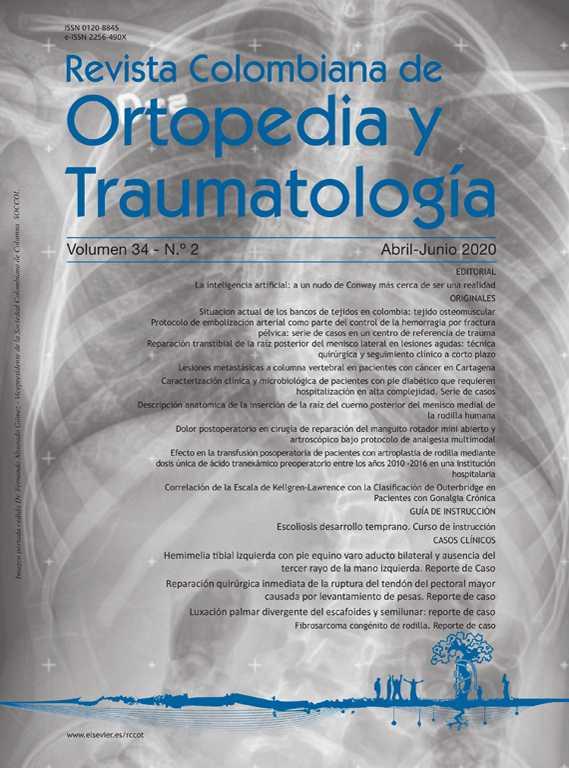Clinical and microbiological profile of patients with diabetic foot requiring admission to a high complexity hospital. Case Series
DOI:
https://doi.org/10.1016/j.rccot.2020.06.009Keywords:
diabetic foot, infection, diabetes mellitus, hospitalisationAbstract
Background: Infected diabetic foot is a frequent complication of diabetes and a marker of patient deterioration. There is little information in Colombia on the characteristics of patients that enter the highly complex emergency services with this condition and their outcomes, such as amputation and microbiological profile.
Materials: Case series of patients admitted to the emergency department of Pablo Tobón Uribe Hospital whose main consultation was infected diabetic foot. The medical records were retrospectively analysed and descriptive statistical tools were used to characterise the population, as well as the variables related to diagnosis, treatment, and early in-hospital outcomes.
Results: Between January 2009 and December 2013, 118 patients with 145 ulcers due to an infected diabetic foot were admitted. The HbA1c was > 6.5 in 90%, and 52% had renal dysfunction, 51% with peripheral arterial disease, and 57% had ulcers grade 3 or higher in the Wagner classification. The infection was polymicrobial in 63%, and 58% required amputation, with 62% of amputations being classed as minor. Mortality was 10%, and mortality attributable to diabetic foot infection or complications derived from amputation was 1.7%.
Discussion: Patients with diabetic foot admitted to the emergency room of a high complexity hospital in Colombia have an advanced systemic disease,related to renal and peripheral vascular dysfunction, and serious local injuries with advanced bone and joint involvement. Given the severity of these conditions, the prevalence of major amputations may be higher than that reported in the literature.
Evidence Level: IV
Downloads
References
International Diabetes Federation. IDF Diabetes Atlas. 8th edition ed.
Triana R. Pie diabético. Fisiopatología y consecuencias. Rev Col Ort Trau 2104;28(4):143-53. https://doi.org/10.1016/j.rccot.2015.04.006
Armstrong DG, Boulton AJM, Bus SA. Diabetic Foot Ulcers and Their Recurrence. N Engl J Med. 2017;376:2367-75. https://doi.org/10.1056/NEJMra1615439
Boulton AJ. The pathway to foot ulceration in diabetes. Med Clin North Am. 2013;97:775-90. https://doi.org/10.1016/j.mcna.2013.03.007
Buggy A, Moore Z. The impact of the multidisciplinary team in the management of individuals with diabetic foot ulcers: a systematic review. J Wound Care. 2017;26:324-39. https://doi.org/10.12968/jowc.2017.26.6.324
Dietrich I, Braga GA, de Melo FG, da Costa Silva Silva ACC. The Diabetic Foot as a Proxy for Cardiovascular Events and Mortality Review. Curr Atheroscler Rep. 2017;19:44. https://doi.org/10.1007/s11883-017-0680-z
King P, Peacock I, Donnelly R. The UK prospective diabetes study (UKPDS): clinical and therapeutic implications for type 2 diabetes. Br J Clin Pharmacol. 1999;48:643-8. https://doi.org/10.1046/j.1365-2125.1999.00092.x
Dean J. Organising care for people with diabetes and renal disease. J Ren Care. 2012;38 Suppl 1:23-9. https://doi.org/10.1111/j.1755-6686.2012.00272.x
Ledoux WR, Shofer JB, Cowley MS, Ahroni JH, Cohen V, Boyko EJ. Diabetic foot ulcer incidence in relation to plantar pressure magnitude and measurement location. J Diabetes Complications. 2013;27:621-6. https://doi.org/10.1016/j.jdiacomp.2013.07.004
Cecilia-Matilla A, Lazaro-Martinez JL, Aragon-Sanchez J, Garcia-Alvarez Y, Chana-Valero P, Beneit-Montesinos JV. Influence of the location of nonischemic diabetic forefoot osteomyelitis on time to healing after undergoing surgery. Int J Low Extrem Wounds. 2013;12:184-8. https://doi.org/10.1177/1534734613502033
Abbas ZG, Lutale JK, Game FL, Jeffcoate WJ. Comparison of four systems of classification of diabetic foot ulcers in Tanzania. Diabet Med. 2008;25:134-7. https://doi.org/10.1111/j.1464-5491.2007.02308.x
Jeon BJ, Choi HJ, Kang JS, Tak MS, Park ES. Comparison of five systems of classification of diabetic foot ulcers and predictive factors for amputation. Int Wound J. 2017;14: 537-45. https://doi.org/10.1111/iwj.12642
Barwell ND, Devers MC, Kennon B, Hopkinson HE, McDougall C, Young MJ, et al. Diabetic foot infection: Antibiotic therapy and good practice recommendations. Int J Clin Pract. 2017; 71(10.). https://doi.org/10.1111/ijcp.13006
Naz I, Walters E, Akbari CM, Attinger CE, Kim PJ. Noninvasive Vascular Assessment of Lower Extremity Wounds in Diabetics: Are We Able to Predict Perfusion Deficits? Surg Technol Int. 2017;31:66-74.
Singer AJ, Tassiopoulos A, Kirsner RS. Evaluation and Management of Lower-Extremity Ulcers. N Engl J Med. 2017;377:1559-67. https://doi.org/10.1056/NEJMra1615243
Pernes JM, Auguste M, Borie H, Kovarsky S, Bouchareb A, Despujole C, et al. Infrapopliteal arterial recanalization: A true advance for limb salvage in diabetics. Diagn Interv Imaging. 2015;96:423-34. https://doi.org/10.1016/j.diii.2014.09.002
Ozan F, Gurbuz K, Celik I, Bestepe Dursun Z, Uzun E. Evaluation of major and minor lower extremity amputation in diabetic foot patients. Turk J Med Sci. 2017;47:1109-16. https://doi.org/10.3906/sag-1601-58
Nerone VS, Springer KD, Woodruff DM, Atway SA. Reamputation after minor foot amputation in diabetic patients: risk factors leading to limb loss. J Foot Ankle Surg. 2013;52:184-7. https://doi.org/10.1053/j.jfas.2012.11.015
Quilici MT, Del Fiol Fde S, Vieira AE, Toledo MI. Risk Factors for Foot Amputation in Patients Hospitalized for Diabetic Foot Infection. J Diabetes Res. 2016;2016:8931508, https://doi.org/10.1155/2016/8931508
Giurato L, Meloni M, Izzo V, Uccioli L. Osteomyelitis in diabetic foot: A comprehensive overview. World J Diabetes. 2017;8:135-42. https://doi.org/10.4239/wjd.v8.i4.135
Lipsky BA, Berendt AR, Cornia PB, Pile JC, Peters EJ, Armstrong DG, et al. 2012 Infectious Diseases Society of America clinical practice guideline for the diagnosis and treatment of diabetic foot infections. Clin Infect Dis. 2012;54:e132-73. https://doi.org/10.1093/cid/cis346
Walsh JW, Hoffstad OJ, Sullivan MO, Margolis DJ. Association of diabetic foot ulcer and death in a population-based cohort from the United Kingdom. Diabet Med. 2016;33:1493-8. https://doi.org/10.1111/dme.13054





